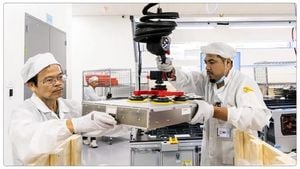China is set to launch the Chang'e-7 mission, which will utilize cutting-edge robotic technology to search for water on the lunar south pole. Scheduled for deployment in 2026, this ambitious project involves several components including an orbiter, lander, rover, and the specially-designed flying robotic detector.
The main goal of the Chang'e-7 mission is to conduct detailed surveys of the moon's south pole, targeting the discovery of ice deposits suspected to exist within permanently shadowed craters. Such findings could have significant implications for human exploration. Tang Yuhua, deputy chief designer of the Chang'e-7 mission, emphasized the importance of this objective, stating, "If lunar water ice is successfully located, it could significantly reduce the cost and time required to transport water from Earth." This water could provide life-sustaining resources for astronauts and may serve as rocket fuel for future missions.
According to Wu Weiren, chief designer of China's Lunar Exploration Project, the lunar south pole might be home to some very deep caves where water may be trapped. He noted, "There are some very deep caves at the south pole of the moon, and we think there may be water there." This insight guides the Chang'e-7 mission's approach to lunar exploration.
The flying robotic detector is particularly fascinating, labeled as an "extremely smart robot" by Tang Yuhua. This innovative device is capable of landing reliably and maneuvering over various slopes on the moon's surface, mimicking human movements when jumping. It is equipped with advanced technology to help it navigate the harsh lunar terrain. Tang described its capabilities by saying, "It can land reliably and repeatedly on different slopes, much like how a human bends their legs when jumping from a height." The robotic explorer is powered by rocket propulsion, enabling it to traverse rugged landscapes and potentially leap several kilometers with each jump.
The necessity for such technology becomes more urgent as Chang'e-7 will face extreme temperatures on the lunar surface, going below -100 degrees Celsius. The robot must operate effectively under these grueling conditions, which represent one of the primary challenges of the mission. Observers note the importance of detailed operational testing, as Tang adds, “To work for a long time under these circumstances is a big challenge.” The robotic detector's design also includes mechanisms to facilitate its operation over the airless lunar environment.
With the Chang'e-7 mission, China reinforces its dedication to becoming a leader in lunar exploration. The mission follows the success of the Chang'e-6 mission, which previously marked China's first return of lunar samples from the far side of the Moon, garnering global attention and interest.
China's efforts reflect broader aspirations to establish human presence on the Moon, with plans already laid out for the Chang'e-8 mission to launch by 2028. This subsequent mission will work alongside Chang'e-7, contributing to the establishment of China's automated lunar exploration network. The ultimate aim is to accomplish crewed missions to the Moon by 2030, positioning China as the second nation to achieve this significant milestone.
Overall, the Chang'e-7 mission is not only pivotal for searching lunar water but also holds the potential to lay the groundwork for establishing future research bases. With the findings from Chang'e-7, the possibility of human habitation on the Moon could become significantly more attainable. The discovery of ice could provide the resources needed for long-term lunar operations, also aiding subsequent missions to Mars and beyond.



